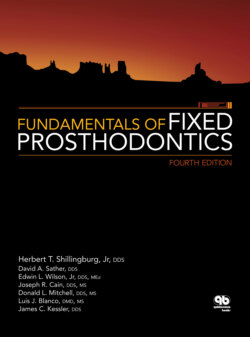Читать книгу Fundamentals of Fixed Prosthodontics - James C. Kessler - Страница 100
На сайте Литреса книга снята с продажи.
Restoration Longevity
ОглавлениеEvery dentist would like to be able to answer the patient’s question, “How long will my restoration last?” Logical though this question may be, unfortunately it is impossible to answer directly. We cannot predict the life span of a pair of shoes or a television set, and these everyday items are not custom made, nor do they perform their service in a hostile biologic environment, submerged in water.
Clinical studies of restoration longevity have produced widely disparate figures. As a general rule, cast restorations will survive in the mouth longer than amalgam restorations, which in turn will last longer than composite resin restorations. 14 A compilation of five studies of 676 patients concluded that amalgam restorations exhibit a 50% failure rate between 5.5 and 11.5 years, with an extrapolated life expectancy of 10 to 14 years.15
Meeuwissen et al16 reported a 10-year survival rate of 58% for amalgam restorations in Dutch military patients; Arthur et al17 reported an 83% survival rate for the same time span in a US military population. Qvist et al18 found that 50% of the amalgam restorations in a group of Danish patients had failed at 7 years. Christensen19 estimated a 14-year longevity for amalgam restorations. In selected populations, amalgam restorations of unspecified types or sizes in one study14 have shown 10-year survival rates as high as 72%. A 15-year survival rate of 72.8% was reported for simple amalgams in another study.20
A survey of 571 fixed prosthodontists, nonspecialist restorative dentists, and dental school faculty projected an average life span of 11.2 years for simple amalgams and 6.1 years for complex amalgams.21 One group of 125 complex amalgams was reported to have a 76% survival rate at 15 years,20 whereas another group of 171 complex amalgam restorations exhibited a 50% survival rate at 11.5 years.22
Composite resin restorations have not been included in many longevity studies. A study of dental school patients that did incorporate them reported a 10-year survival rate of 55.9%.14 Another report, based on a general patient population, described a shorter life span for composite resin restorations, with 50% of them having failed in 6.1 years.23
Mount24 disclosed an overall success rate of 93% for 1,283 glass-ionomer restorations for up to 7 years, with the rate varying from 2% to 36% depending on the class of cavity and the brand of cement. In that study, the patients evaluated had been treated by only two dentists, and not all of the restorations had been in place for the full 7-year span of the study. While promising, these figures must be assessed cautiously until longer studies of a broader population have been completed.
Schwartz et al,25 after studying a group of 791 failed restorations, reported mean life spans, at failure, of 10.3 years for full crowns, 11.4 years for three-quarter crowns, and 8.5 years for porcelain jacket crowns (anterior all-ceramic crowns). The mean life span for all fixed prosthodontic restorations was 10.3 years. Walton and associates,26 evaluating a group of 424 restorations, found full crowns lasting 7.1 years, partial veneer crowns 14.3 years, metal-ceramic crowns 6.3 years, inlays and onlays 11.2 years, and porcelain jacket crowns 8.2 years.
The dentists responding to Christensen’s survey estimated the longevity of crowns to be from 21 to 22 years.19 The estimates supplied by the respondents to a survey by Maryniuk and Kaplan21 were 12.7 years for metal-ceramic crowns and 14.7 years for all-gold restorations. Kerschbaum,27 examining German insurance records, found 91.5% of gold crowns still in the mouth after 8 years. In a review of records in 40 Dutch dental offices, Leempoel et al28 told of 10-year survival rates of 98% and 95.3% for full crowns and metal-ceramic crowns, respectively.
A compilation of longevities from several studies is presented in Table 6-2.
The question of longevity is an important one to consider when choosing treatment for a patient. The more destructive the preparation required for the restoration, the greater the potential risk for the tooth and ultimately the greater expense. In 1989, it was estimated that if a crown were placed in a patient’s mouth at age 22, at a fee of $425, attendant services and replacements of that crown would cost the patient nearly $12,000 considering an average life expectancy of 75 years.32 Today, the original fee may be double, or $850, with a corresponding doubling of the subsequent effect, resulting in a cost to the patient of nearly $24,000.
Table 6-2 Longevity of single-tooth restorations
